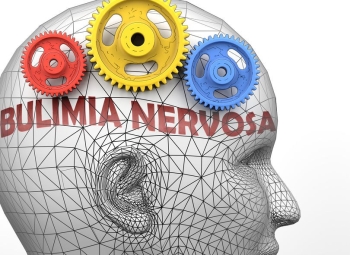
How common is Bulimia Nervosa? Bulimia affects 1% to 4% of the population. It is more common than Anorexia but usually more difficult for friends and family to detect. Approximately 1% to 3% of middle school girls and High school girls suffer from Bulimia Nervosa. Approximately 4% of women in college have Bulimia. Approximately 5% of people with Bulimia are male.
The mortality rate for Bulimia is estimated to be between 5% to 10%.
Bulimia nervosa, an eating disorder characterized by cycles of binge eating followed by behaviors such as vomiting, excessive exercise, or the use of laxatives to compensate for the binge, can develop at various ages. However, it often tends to manifest during adolescence or early adulthood. Here's a general overview:
- Adolescence: Many cases of bulimia nervosa start during adolescence, typically around ages 15 to 25. Adolescence is a period of significant physical and psychological changes, social pressures, and self-image concerns, which can contribute to the development of eating disorders.
- Early Adulthood: Bulimia can also emerge in early adulthood, continuing into the late 20s and early 30s. This period is marked by increased independence, higher academic or career demands, and ongoing identity and self-esteem concerns.
- Later Onset: While less common, bulimia can develop in individuals at later ages as well. It's essential to recognize that eating disorders can affect people of any age.
It's important to note that eating disorders can affect individuals regardless of age, gender, or background. The causes of bulimia are complex and may involve a combination of genetic, biological, psychological, and environmental factors, including societal pressures related to body image, dieting, and cultural ideals of beauty.
If you or someone you know is struggling with disordered eating patterns or shows signs of an eating disorder like bulimia nervosa, seeking professional help is crucial. Early intervention and appropriate treatment greatly increase the chances of recovery. A licensed mental health professional or healthcare provider can provide assessment, diagnosis, and guidance for managing and overcoming eating disorders.
Signs of Bulimia
Bulimia nervosa is an eating disorder characterized by a cycle of binge eating followed by behaviors to compensate for the excessive calorie intake, such as vomiting, excessive exercise, or the use of laxatives. Recognizing the signs of bulimia can be important for early intervention and seeking help. Keep in mind that individuals with bulimia may not exhibit all of these signs, and symptoms can vary. Here are some common signs and symptoms of bulimia:
Behavioral Signs:
- Binge Eating: Consuming a large amount of food within a short period, feeling a lack of control over eating during binges.
- Compensatory Behaviors: Engaging in behaviors to "compensate" for binge eating, such as self-induced vomiting, excessive exercise, fasting, or the misuse of laxatives, diuretics, or enemas.
- Secretive Behavior: Trying to hide eating patterns, excessive bathroom use after meals, or other signs of compensatory behaviors.
- Frequent Dieting: Frequent and strict dieting, often with rapid fluctuations in weight.
- Body Dissatisfaction: Intense dissatisfaction with body shape and weight, preoccupation with appearance.
- Social Withdrawal: Avoiding social situations involving food to hide eating behaviors or negative body image.
Physical Signs:
- Weight Fluctuations: Fluctuations in weight, possibly due to bingeing and purging behaviors.
- Gastrointestinal Issues: Frequent vomiting can lead to swollen salivary glands, sore throat, acid reflux, and stomach pain.
- Dental Problems: Frequent vomiting can lead to dental issues like enamel erosion, cavities, and gum problems.
- Dehydration and Electrolyte Imbalances: Excessive vomiting or laxative use can lead to electrolyte imbalances, causing weakness, dizziness, and even heart problems.
- Fatigue: Malnutrition and electrolyte imbalances can result in tiredness and lack of energy.
- Swelling: Fluid retention due to compensatory behaviors can cause swelling, particularly in the face and hands.
- Menstrual Irregularities: Missed periods or irregular menstrual cycles due to hormonal disruptions caused by extreme weight loss or excessive exercise.
- Calluses or Scars: Calluses on knuckles or scars on the back of the hands from self-induced vomiting.
Emotional and Psychological Signs:
- Low Self-Esteem: Strong negative feelings about self-worth and self-esteem, often tied to body image.
- Depression and Anxiety: Frequent feelings of depression, anxiety, or mood swings.
- Obsession with Weight and Food: Preoccupation with food, calories, weight, and appearance.
- Feelings of Guilt and Shame: Following binge-purge episodes, feelings of guilt, shame, and distress.
- Perfectionism: High standards for self and fear of failure, which may extend to body image and eating habits.
If you suspect that you or someone you know is struggling with bulimia or any other eating disorder, it's important to seek help from a medical professional or mental health expert. Early intervention and appropriate treatment can significantly improve outcomes and support the journey to recovery.
Basic Steps of Supporting Someone with Bulimia
Supporting someone with bulimia requires compassion, patience, and understanding. It's important to approach the situation with sensitivity and avoid judgment. Here are some steps you can take to support someone who is struggling with bulimia:
- Educate Yourself: Learn about bulimia nervosa, its signs, symptoms, and potential complications. This knowledge will help you better understand what the person is going through.
- Initiate a Conversation: Approach the person in a private and non-confrontational setting. Express your concern for their well-being and let them know you're there to support them.
- Listen Without Judgment: Allow the person to share their feelings and experiences without interrupting or passing judgment. Let them know that you're there to listen and support them.
- Show Empathy: Be empathetic and understanding of their struggles. Avoid making comments that could be perceived as critical or dismissive.
- Offer Emotional Support: Let the person know that you care about their well-being and that you're there to support them through their recovery journey.
- Encourage Professional Help: Gently suggest that they seek help from a qualified healthcare provider, therapist, or counselor who specializes in eating disorders.
- Avoid Food and Weight Discussions: Avoid discussing food, diets, weight, or appearance, as these topics can trigger anxiety and worsen the situation.
- Encourage Open Communication: Let the person know that they can talk to you about their thoughts and feelings without fear of judgment.
- Be Patient: Recovery from an eating disorder takes time. Be patient and understanding as the person works through their challenges.
- Help Identify Triggers: If the person is comfortable, help them identify triggers that contribute to their bulimic behaviors. This can assist them in developing coping strategies.
- Encourage Healthy Coping Mechanisms: Help them explore and develop healthier ways to cope with stress, anxiety, and emotions that don't involve bingeing and purging.
- Avoid Enabling Behaviors: Avoid enabling their disordered behaviors. If you suspect they've engaged in purging or other harmful behaviors, encourage them to seek professional help.
- Support Their Treatment Plan: If the person seeks professional treatment, offer to help with logistics, like transportation to appointments, if possible.
- Celebrate Small Wins: Acknowledge and celebrate any progress they make toward recovery, no matter how small. Positive reinforcement can be motivating.
- Take Care of Yourself: Supporting someone with an eating disorder can be emotionally challenging. Ensure you're taking care of your own well-being by seeking your own support if needed.
Remember that you're not responsible for their recovery, but your caring and support can play a significant role in helping them on their journey toward healing. Encourage them to seek professional help and be a source of comfort and understanding as they navigate their recovery from bulimia nervosa.
At TCFG you can schedule directly online with an eating disorder therapist. If you prefer talking to an eating disorder therapist first, you may call (215) 922-LOVE (5683) ext 100 to be connected with our intake department. Lastly, you can call our Director, “Alex” Caroline Robboy, CAS, MSW, LCSW at (267) 324–9564 to discuss your particular situation. For your convenience, we have six physical therapy offices and can also provide counseling and therapy virtually.
- Ocean City Therapy Office
360 West Ave, Floor 1, Ocean City, NJ 08226 - Mechanicsville Therapy Office
9044 Mann Drive, Mechanicsville Virginia, 23116 - Providence Therapy Office
173 Waterman St. Providence, RI 02906 - Society Hill Therapy Office
233 S. 6th Street, C-33, Philadelphia PA 19106 - Art Museum / Fairmount Therapy Office
2401 Pennsylvania Ave, Suite 1a2, Philadelphia PA 19130 - Santa Fe Therapy Office, 2204 B Brothers Road, Santa Fe, New Mexico, 87505
- Telemedicine: We have therapists who are licensed to work in Delaware, Connecticut, Florida, Georgia, New Jersey, New Mexico, Pennsylvania, Rhode Island, and Virginia.
OUR GUARANTEE: you deserve the best eating therapist possible. If you don't feel like the eating disorder therapist that you met with was the right fit, then free of charge you can try out a different therapist. Being in a group practices allows for flexibility.
The Center for Growth has offices in multiple states. We offer both Couples Counseling and Marriage Therapy in person as well as virtual appointments.
The Center for Growth Therapy Offices in PA, NJ, VA, RI, NM, CT
Therapy Services Offered in Philadelphia, Ocean City, Mechanicsville, Providence, Santa Fe:
Individual Counseling and therapy
Couples Counseling and marriage counseling
Teen Therapy and Adolescent Therapy and tweens and child counseling
Family Therapy and multi-generational counseling
Art Therapy and Counseling no art skills needed
ADHD Therapyand ADD, Dyslexia, Autism, Tourettes counseling
Anxiety, Panic, OCD Therapy and worry and fear support
Breaking the cycle of Codependency and being your own person
Overcoming Chronic Illness and Chronic Pain .
Depression Therapy and sadness, gloom, and upset support
- Functional Neurological Disorder (FND) Therapy is a particular style of therapy designed for people with problems affecting their nervous system, how the brain and body send and receive signals.
Grief Therapy and loss, End of A Relationship, rejections, pregnancy and loss and therapy
Mindfulness Based Therapy and spirituality based therapy
- Narcissistic Abuse Recovery child of, parent of, spouse of, sibling of a narcissist.
Sex Therapy and sexual function & dysfunction, sex addiction, sexual orientation and gender identity support
Shame and Blame
Trauma Therapy both emotional and sexual abuse, complex trauma, PTSD counseling
Divorce support
Affairs, Infidelity, Unfaithful, Cheating counseling
Parenting therapy Parenting therapy
Personality disorder therapy Personality disorder treatments
Anger Management Therapy anger therapy
Setting Boundaries and identifying ones own Core Beliefs
Just name some of the Mental Health issues that we work with. Our goal is to help you Change and Achieve Your Dreams
While eating disorders are serious and complex conditions, here are some intriguing and lesser-known facts related to Eating Disorders:
- Historical References: Early historical accounts suggest that behaviors resembling modern eating disorders have been documented throughout history. For example, ancient texts mention individuals who exhibited patterns similar to anorexia nervosa.
- Rumination Disorder: Rumination disorder is an eating disorder characterized by regurgitating food, re-chewing it, and either re-swallowing or spitting it out. This disorder is often seen in infants and individuals with intellectual disabilities.
- Pica: Pica is an eating disorder characterized by consuming non-nutritive, non-food substances such as dirt, clay, paper, chalk, or ice. It's more common in children, pregnant women, and individuals with developmental disorders.
- Orthorexia Nervosa: Although not officially recognized as a separate disorder in diagnostic manuals, orthorexia nervosa refers to an unhealthy obsession with eating "pure" or "clean" foods, often at the expense of overall nutrition and well-being.
- Mirrored Neurons: Some research suggests that individuals with eating disorders might have altered mirror neuron activity. Mirror neurons are brain cells that play a role in empathy and understanding the actions of others.
- Mortality Rates: Eating disorders have one of the highest mortality rates of any mental health disorder. This is often due to medical complications related to malnutrition, electrolyte imbalances, and other health risks.
- Unique Language: People with eating disorders often use coded language to discuss their behaviors without drawing attention. For instance, they might refer to certain behaviors as "clean eating" or use acronyms to describe their actions.
- Cultural Variability: Cultural ideals of beauty and body image significantly influence the development of eating disorders. However, the specific forms and expressions of these disorders can vary across cultures.
- Positive Coping Mechanisms: In some cases, individuals develop eating disorders as a way to cope with overwhelming emotions or traumatic experiences. The disorder serves as a way to gain a sense of control.
- Stress Response: Certain eating disorders, like binge eating disorder, might be triggered by the body's response to chronic stress. The brain's reward system can become involved in these behaviors.
- Binge Eating Disorder: Binge eating disorder is characterized by recurrent episodes of overeating in a short period. It is the most common eating disorder in the United States and affects both men and women.
- Body Checking and Avoidance: People with body dysmorphic disorder (BDD), which often co-occurs with eating disorders, engage in excessive checking and avoidance behaviors related to perceived flaws in appearance.
- Chewing and Spitting: Chewing and spitting out food without swallowing is a behavior seen in some eating disorders. It can be a way to experience the taste of food without consuming calories.
- Brain Changes: Certain brain regions, such as the insula, are implicated in eating disorder behaviors. These brain changes can contribute to altered perceptions of hunger, fullness, and body image.
- Comorbidity: Eating disorders often co-occur with other mental health conditions, highlighting the complexity of these disorders and the need for holistic treatment approaches.
While these facts provide insight into various aspects of eating disorders, it's essential to remember that these are serious conditions requiring professional help and support. If you or someone you know is struggling with an eating disorder, seeking guidance from qualified healthcare professionals is crucial.






















